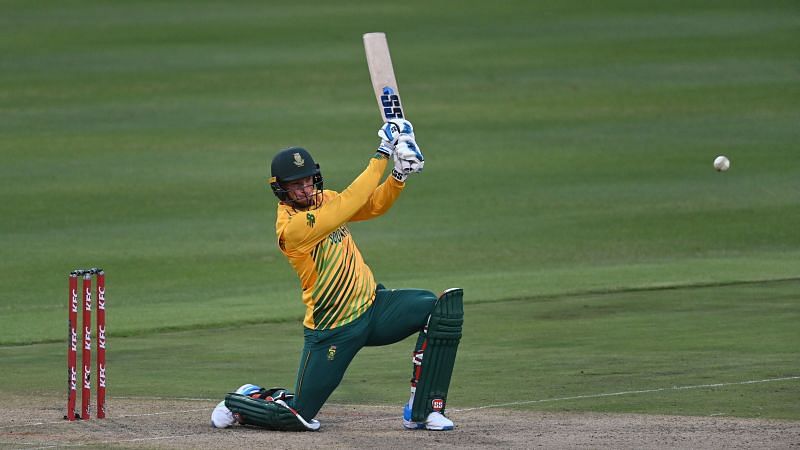
Pakistan and South Africa show why they're lifetimes away from the ODI perch

On 2nd April, 2021, under the blinding Pretorian floodlights, Pakistan somehow veered themselves into a predicament, where they needed 14 runs off the final two overs. Prior to that, the Asian outfit had called the shots in the second innings and had fashioned a position of dominance, courtesy a marvelous Babar Azam ton.
Post the Pakistan captain’s dismissal, though, the visitors tried their utmost to squander their advantage and offer the hosts an avenue back into the game. That the latter managed to bring the equation down to 3 runs required off 2 balls perhaps captures the story completely.
Thereafter, Pakistan possessed the requisite calmness to get over the line and surge ahead in a series that promises to be just as topsy-turvy. Yet, the manner of the victory also shed light on another trait – one that has become eerily synonymous to both. And, if one were to be a little blunter, it only highlighted why Pakistan and South Africa are no longer looked upon as the gold standard in ODI cricket.
To put things into perspective, Pakistan won the toss and elected to bowl first on a surface that was a tad tacky. As expected, the ball decked around, meaning that Mohammad Hasnain and Shaheen Shah Afridi kept the batsmen on their toes, at least in the first two overs.
All of a sudden, though, Quinton de Kock clicked into gear and attacked Pakistan’s premier pacer (Shaheen Shah Afridi). The wicket-keeper bagged a couple of boundaries in the 3rd over before Markram joined in on the fun, cracking a sumptuous back foot punch past extra cover off Hasnain.
Rather amazingly, in the space of a few deliveries, it seemed as if South Africa had turned the tables on Pakistan and that they would optimize the Power Play fully. Just as the head of steam was being generated, the hosts extinguished it with a string of rash strokes.

While Quinton de Kock picked the wrong length to play the lofted cover-drive, Markram found himself too committed to the front foot – something that dwindled his ability to tackle the ball that stopped. Temba Bavuma, on the other hand, picked out the fielder at third man to perfection when attempting the uppercut.
The rest of the Power Play came about without any mishaps for the hosts, with Pakistan tightening the screws expertly. In fact, they were so tidy with their lines and lengths that Heinrich Klaasen took 19 balls to get off the mark. For the uninitiated, it was the 2nd slowest (in terms of balls) any South African has ever managed in ODI cricket.
Hence, when Pakistan reduced South Africa to 55/4 inside fifteen overs, they were firmly in the ascendancy. However, this also meant that the baton of lackadaisicalness was then passed over from the hosts to the visitors. Not the most ideal changing of the guard, one must say.
Over the course of the next few hours, Pakistan suddenly fell off a cliff, meaning that they allowed the Proteas to mount a comeback. More importantly, though, the lack of intensity after the early jolts enabled the hosts to establish a foothold in the game.

Unsurprisingly, South Africa, courtesy some excellent rear-guard action, powered their way to 274/6, despite looking likely to post a total much lower than that for a major chunk.
Thus, if one were to only look at the latter part of South Africa’s innings, one might be tempted to label their rescue act as extraordinary. On further introspection, though, one might conclude that they dug their own grave before having to rely on something stupendous.
As for Pakistan, their bowling between overs 15-40 lacked any sort of conviction or rhythm. Even when David Miller walked out to the centre, Pakistan offered him loose deliveries to break the shackles.
To put things into context, each of David Miller’s opening five boundaries were scored off the back foot. While that particular barrage included four cut strokes, one boundary was accumulated via a fine leg glance.
Unsurprisingly, Pakistan’s patchy bowling effort continued through the rest of the innings, meaning that South Africa hauled themselves to 274/6, which on a strip that wasn’t too conducive for stroke-making seemed a challenging target.
Pakistan began their run-chase brilliantly
When Pakistan began batting, though, the pitch seemed anything but challenging. Babar Azam and Imam-ul-Haq, at least for a major chunk of their essays, were that good.
The Pakistan skipper unfurled shots all across the park and caressed his way to his 13th ODI century. At that juncture, Pakistan had amassed 186 runs for the loss of a solitary wicket. That they did it inside 32 overs only added another layer of magnificence to their efforts.
Yet, just as the Asian outfit might’ve begun harboring hopes of a comfortable run-chase, they uncannily pushed the self-destruct button.
Moments after reaching his ton, Babar Azam had a loose waft outside off stump. Again, something that seemed so uncharacteristic, considering what had transpired prior to it. For some reason, that particular outcome seemed inevitable, especially after Babar Azam looked visibly overawed by just getting past the 100-run barrier.
Imam followed suit in the 34th over when he tried to pull Anrich Nortje into oblivion. However, on a track that had previously showcased a double-paced nature, the decision was hardly inspiring.
A string of wickets followed, with Danish Aziz perishing to Nortje as well. The most shocking of dismissals, though, was that of Asif Ali.
For those wondering, Asif Ali has been part of Pakistan’s set-up for quite a while but has rarely set the stage alight. In ODIs, he averages well under 30, while that average dwarfs further in T20Is, where his corresponding tally is 17.78.
Throughout his career, though, he has portrayed a weakness against the rising delivery – a pattern that fast bowlers barely ever miss. And on Friday, Nortje exploited that to the tee, with Asif Ali eventually deploying an agricultural swipe across the line.
Thus, in a sequence of events that lasted all of 35 balls, Pakistan found themselves staring down a barrel. Most tellingly, though, it arrived after a stretch where they seemed to have an answer for each question South Africa posed.

The game ultimately meandered deep into the death overs, with Pakistan somehow still needing 14 runs off the final two overs. At that point, though, Lungi Ngidi was the one to flinch as he allowed Shadab Khan a reprieve (off a waist-high No Ball) and then gave him the opportunity to bring out a booming cover drive.
Yet, even then, Pakistan managed to get into a situation where 3 runs were needed off only two balls, despite requiring the same number of runs from the entirety of the final over.
In a nutshell, owing to Pakistan’s tendency to flicker between the mesmerizing and the mediocre, they had indicated why they continue to be considered also-rans in ODI cricket. Or, in Ramiz Raja's words, Pakistan have mastered the art of complicating things that could have a straightforward conclusion.
Rather incredibly, though, that is the exact ailment currently plaguing South Africa, with them also alternating between the exceptional and the exasperating.
While the neutral might not have fretted too much, for the sheer entertainment Pakistan and the Proteas provided, it would certainly have caused more than a furrowed brow in both camps.
Frustratingly, both outfits have made it a habit to illustrate their Dr. Jekyll and Mr. Hyde personalities quite regularly. And, if one were to contest that argument, they might perhaps be better served brooding over what went down at SuperSport Park on Friday.
Maybe then, it isn’t a coincidence that Pakistan and South Africa find themselves lifetimes away from the perch of ODI cricket.